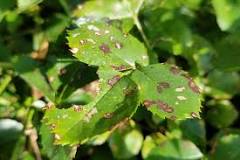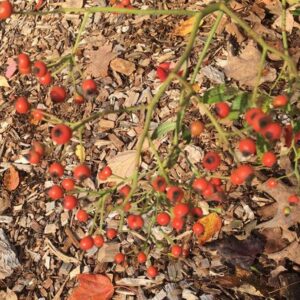As the roses in the garden make their final display for 2023, visitors might wonder how the roses are cared for in the fall so that they survive the winter. The Columbus Park of Roses adheres to a few guidelines:
Minimize disease. It is most important that roses have enough water and are free of disease as they move into winter and go dormant. The latter can be accomplished by removing leaves with signs of disease and raking away fallen leaves. Diseased leaves should never be put into a compost pile. 
Minimize late season growth. This is accomplished by no longer deadheading (cutting off spent blooms) and fertilizing at some point. This year, deadheading was not done after mid-September because pruning spurs growth. This also allows rose hips, a winter food source for birds, to develop. 
Late season growth puts rose bushes at risk for damage. If growth were encouraged at this time of year, tender new shoots would take power from the plant. Also, if a plant has tender shoots that are damaged by hard frosts or freezing, the bush might become vulnerable to freezing out. For the same reason, it is also not a good idea to fertilize late in the growing season in order to lessen the plants from growing. At the CPOR, fertilization ends mid-August.
Protect roots. Our roses are mulched high enough to protect the graft union. The graft area is especially susceptible to winter injury.
Protect climbing roses. These are more prone to wintertime damage, especially in harsh weather. It is important to prevent long canes from being whipped by wind or loaded down with heavy snow. They can be secured to a trellis, or even tied together and secured on the ground. 
When the weather gets colder, the roses begin to go dormant, and their energy reserves move into their roots to help them survive the winter. With our increasingly mild winters, it is nice to see a lot of the plants stay green throughout the winter as we eagerly await the first full bloom next June.
